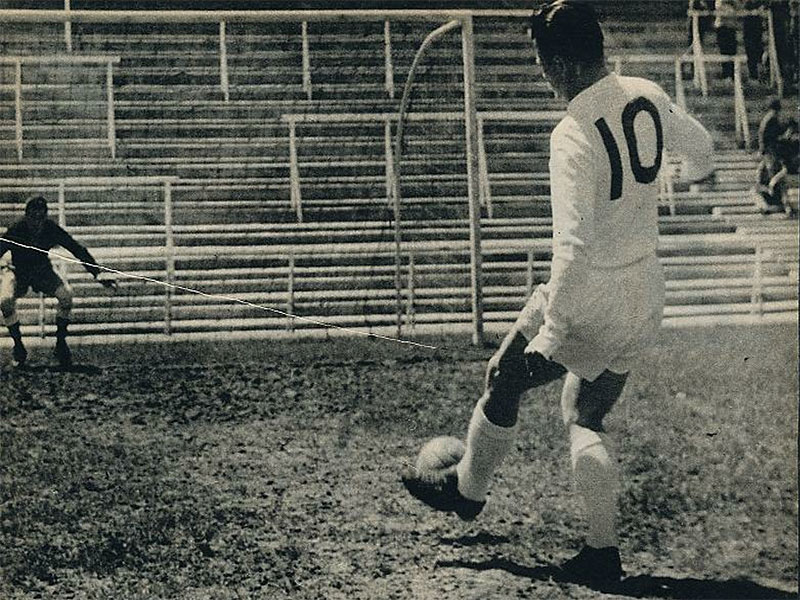Legends of La Liga
Ferenc ‘Pancho’ Puskás and Hungarian footballers in El Clásico
Ferenc ‘Pancho’ Puskás and Hungarian footballers in El Clásico
Hungary reached the football World Cup final in 1954 and, although they didn’t win, its Hungarian national team of the 1950s became legendary. This is the story of Ferenc ‘Pancho’ Puskás and the ‘Golden Team’ generation which made its mark on Spanish football.

In the post-war era, Hungary’s national football team was supported and promoted by the Communist Hungarian People's Republic. In the wake of the 1956 Hungarian Revolution, however, the eleven players of its national team were scattered throughout the world.
The majority of the team played for the club side Budapest Honvéd, who played Athletic Bilbao in the 1956–57 European Cup. Honvéd lost the away leg 3–2 but, before the home leg could be played, the Hungarian Revolution erupted in Budapest.
The players decided against going back to Hungary, so the return leg was relocated to the Heysel Stadium in Brussels. When Honvéd were eliminated 6–5 on aggregate, the Hungarian players were left in limbo. They summoned their families from Budapest and organised a fundraising tour of Italy, Portugal, Spain, and Brazil. After returning to Europe, the Hungarian players parted ways and several of them began club careers in Spain.
Ferenc Puskás, the outstanding player of the Golden Team, did not return home to Hungary. From 1958 to 1966 he played for Real Madrid in Spain. In his first two years there, Puskás was banned by FIFA (under political pressure) from playing football. Struggling with excess weight and at 30, already an ageing footballer, Puskás nonetheless strived to rebuild his career and his fitness.
After his defection, the Communist regime’s beloved star Puskás became its enemy. Hungarian state security launched treason proceedings against Puskás and opened a file on him called "Wanderer" (this file was opened on 20 May 1958 and closed on 26 June 1972).
Despite the odds being stacked against him, Puskás played for Real Madrid throughout his thirties. His training and hard work bore fruit. In this second phase of his career, he scored many goals and dazzled the world with his skills.
Puskás was not the only Hungarian footballer to find success in Spain. The FC Barcelona players László Kubala (), Zoltán Czibor and Sándor Kocsis were also revered. Like Puskás, they had arrived in Spain after the 1956 Revolution, and restarted their careers there.
These Hungarian players became legends of the El Clásico derby matches between club rivals Real Madrid and FC Barcelona. Kubala scored twice in thirteen matches against Real Madrid, and Kocsis scored twice in three. Madrid’s beloved ‘Pancho’ (his Spanish nickname) Puskás celebrated eight victories in ten matches, and nine goals in total against Barcelona in the championship. His shots on goal were likened to cannon fire in Catalonia.
Ha la stoffa dei campioni, LUCE, In Copyright
Back in Hungary, however, news of Puskás’s success was suppressed by the Communist system for years. In spite of this, the glory of the Golden Team and the cult of Puskás grew stronger over time. The captain of the Golden Team returned home for the first time in 1981 when he played a gala match against England. Puskás later worked as a coach in North and South America, Spain, Greece, and Egypt.
Puskás returned to Hungary in 1991 and lived the rest of his life there until his death in 2006. After the fall of Communism, Puskás became widely remembered as one of the greatest footballers of all time. In 2002 Budapest’s People's Stadium was renamed the Ferenc Puskás Stadium, and in 2020, on the same site, European Championship matches will be played in a new arena - the Puskás Arena.
Watch a Hungarian TV interview with Ferenc Puskás from 1985 here.
This blog post is a part of the Migration in the Arts and Sciences project, which explored how migration has shaped the arts, science and history of Europe.